Mikalojus Konstantinas Čiurlionis
Mikalojus Konstantinas Čiurlionis (Polish: Mikołaj Konstanty Czurlanis; 22 September [O.S. 10 September] 1875 – 10 April [O.S. 28 March] 1911) was a Lithuanian painter, composer and writer.[1]
Mikalojus Konstantinas Čiurlionis Mikołaj Konstanty Czurlanis | |
|---|---|
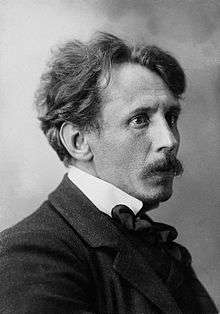 | |
| Born | Mikalojus Konstantinas Čiurlionis 22 September 1875 |
| Died | 10 April 1911 (aged 35) Marki, Congress Poland, Russian Empire |
| Nationality | Lithuanian |
| Education |
|
| Known for | Painting, musical composition |
Notable work |
|
| Movement |
|
| Spouse(s) | Sofija Kymantaitė-Čiurlionienė |
Čiurlionis contributed to symbolism and art nouveau, and was representative of the fin de siècle epoch. He has been considered one of the pioneers of abstract art in Europe.[2] During his short life, he composed about 400 pieces of music and created about 300 paintings, as well as many literary works and poems. The majority of his paintings are housed in the M. K. Čiurlionis National Art Museum in Kaunas, Lithuania. His works have had a profound influence on modern Lithuanian culture.
Biography
Mikalojus Konstantinas Čiurlionis was born in Senoji Varėna, a town in southeastern Lithuania that at the time was in the Russian Empire. He was the oldest of nine children of his father, Konstantinas, and his mother, Adelė née Radmanaitė (Radmann), who was descended from a Lutheran family of Bavarian origin. Like many educated Lithuanians of the time, Čiurlionis's family spoke Polish, and he began learning Lithuanian only after meeting his fiancée in 1907.[3] In 1878, his family moved to Druskininkai, 30 mi. (50 km) away, where his father went on to be the town organist.
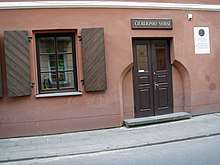
Čiurlionis was a musical prodigy: he could play by ear at age three and could sight-read music freely by age seven. Three years out of primary school, he went to study at the musical school of Polish Prince Michał Ogiński in Plungė, where he learned to play several instruments, in particular the flute, from 1889 to 1893. Supported by Prince Ogiński's 'scholarship' Čiurlionis studied piano and composition at Warsaw Conservatory from 1894 to 1899.[4] For his graduation, in 1899, he wrote a cantata for mixed chorus and symphonic orchestra titled De Profundis, with the guidance of the composer Zygmunt Noskowski. Later he attended composition lectures at the Leipzig Conservatory from 1901 to 1902.
He returned to Warsaw in 1902 and studied drawing at the Warsaw School of Fine Arts from 1904 to 1906,[4] and became a friend with Polish composer and painter Eugeniusz Morawski-Dąbrowa. His main teacher in Warsaw was symbolist painter Kazimierz Stabrowski, who was also the founder of the first lodges of the Theosophical Society in Poland and passed to Čiurlionis an interest in Theosophy and other esoteric subjects.[5] After the 1905 Russian Revolution, which resulted in the loosening of cultural restrictions on the Empire's minorities, he began to identify himself as a Lithuanian.[3]
He was one of the initiators of, and a participant in, the First Exhibition of Lithuanian Art in 1907 at Vileišis Palace, Vilnius. Soon after this event, the Lithuanian Union of Arts was founded, and Čiurlionis was one of its 19 founding members.
In 1907, he became acquainted with Sofija Kymantaitė (1886–1958), an art critic. Through this association Čiurlionis learned to speak better Lithuanian. Early in 1909, he married Kymantaitė. At the end of that year, he traveled to St. Petersburg, where he exhibited some of his paintings. On Christmas Eve, Čiurlionis fell into a profound depression and at the beginning of 1910 was hospitalized in a psychiatric hospital "Czerwony Dwór" (Red Manor) in Marki, Poland, northeast of Warsaw. While a patient there, he died of pneumonia in 1911 at 35 years of age. He was buried at the Rasos Cemetery in Vilnius. He never saw his daughter Danutė (1910–1995).
Čiurlionis felt that he was a synesthete; that is, he perceived colors and music simultaneously. Many of his paintings bear the names of musical pieces: sonatas, fugues, and preludes.
Posthumous recognition
.jpg)
In 1911, the first posthumous exhibition of Čiurlionis's art was held in Vilnius and Kaunas. During the same year, an exhibition of his art was held in Moscow, and in 1912 his works were exhibited in St. Petersburg. In 1944, the main art museum in Kaunas was renamed M. K. Čiurlionis National Art Museum and still hosts the majority of Čiurlionis paintings.[6] In 1957, the Lithuanian community in Chicago opened the Čiurlionis Art Gallery, hosting collections of his works. In 1963, the Čiurlionis Memorial Museum was opened in Druskininkai, in the house where Čiurlionis and his family lived. This museum holds biographical documents as well as photographs and reproductions of the artist's works. The National M. K. Čiurlionis School of Art in Vilnius was named after him in 1965.[7]
Čiurlionis inspired the Lithuanian composer Osvaldas Balakauskas' work Sonata of the Mountains (1975), and every four years junior musical performers from Lithuania and neighboring countries take part in the Čiurlionis Competition. Čiurlionis's name has been given to cliffs in Franz Josef Land, a peak in the Pamir Mountains, and to asteroid #2420, discovered by the Crimean astrophysicist Nikolai Chernykh.
Čiurlionis's works have been displayed at international exhibitions in Japan, Germany, Spain, and elsewhere. His paintings were featured at "Visual Music" fest, an homage to synesthesia that included the works of Wassily Kandinsky, James McNeill Whistler, and Paul Klee, at the Museum of Contemporary Art, Los Angeles in 2005.[8]
In 2009, Genovaitė Kazokas (Genovaitė Kazokienė ) published Musical Paintings, a book where she argued that Theosophy, esotericism and Spiritualism were important influences on Čiurlionis’ art.[9]
A commemorative plaque has been placed on the building of the former hospital in Marki, Poland where Mikalojus Konstantinas Čiurlionis died in 1911.
Čiurlionis's life was depicted in the 2012 film Letters to Sofija, directed by Robert Mullan.
Musical works
The precise number of Čiurlionis musical compositions is not known – a substantial part of his manuscripts did not survive, including those that perished in the fire during the war. The ones available for us today include sketches, rough drafts, and fragments of his musical ideas. The nature of the archive determined the fact that Čiurlionis' works were finally published only a hundred years after the composer's death. Today, the archive amounts to almost 400 compositions, the major part of which are works for piano, but also significant opuses for symphony orchestra (symphonic poems In the Forest and The Sea, overture, cantata for choir and orchestra), string quartet, works for various choirs (original compositions and Lithuanian folk song arrangements), as well as works for organ.
Some of his most-performed musical works include:
- Nocturne in C-sharp minor
- Prelude in F-sharp major
- Nocturne in F minor
- Impromptu in F-sharp minor
- String Quartet in C minor
- Prelude in A major
- Prelude in D flat major
- Fugue in B minor
- Prelude in B minor
- Prelude in D minor
- Karalaitės kelionė: Pasaka (The Princess's Journey: A Fairy Tale)
- Seven fugues for organ (Fugue in G minor)
- Folk songs for choir
- De Profundis, for choir and orchestra
- Miške (In the Forest), symphonic poem for orchestra (posthumous)
- Jūra (The Sea), symphonic poem for orchestra (posthumous)
Paintings
Some of the most popular[10] Mikalojus Konstantinas Čiurlionis paintings include:
- The Gift of Friendship (1906)
- Cycle Winter (1906–1907)
- Cycle The Zodiac (1907)
- Sonatas (1907–1908)
- Cycle Fairy-Tale (1909)
- Creation of the World
- Sonata of the Spring (1907)
- Sonata of the Summer (1908)
- Sonata of the Sun (1907)
- Sonata of the Sea (1908)
- Sonata of the Pyramids (1908)
- Stellar Sonata (1908)
- Sonata of the Serpent (1908)
- Diptych Prelude and Fugue (1908)
- Triptych Fantasy (1908)
- Other Preludes and Fugues
- Winter – Cycle of Eight Pictures (1906–7)
- Spring – Four Pictures (1907–8)
- Summer – Cycle of Three Pictures (1907–8)
Gallery
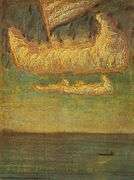 Cloud Boat (1906)
Cloud Boat (1906)_-_1908.jpg) Andante - IV (1908)
Andante - IV (1908)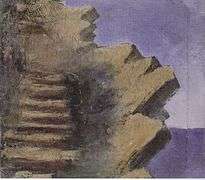 Cliff at the Seaside (1905)
Cliff at the Seaside (1905)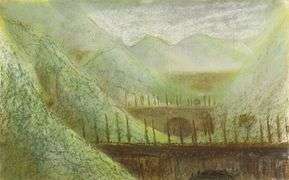 Bridges (1904)
Bridges (1904)_-_1909.jpg) Angel (1908)
Angel (1908)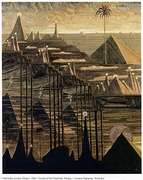 Pyramids (1908)
Pyramids (1908)_-_1905_-_6%2C_Varsuva.jpg) Creation of the World - II (1905–06)
Creation of the World - II (1905–06)_-_1905_-_6%2C_Varsuva.jpg) Creation of the World - III (1905–06)
Creation of the World - III (1905–06)_-_1905_-_6%2C_Varsuva.jpg) Creation of the World - V (1905)
Creation of the World - V (1905)_-_1905_-_6%2C_Varsuva.jpg) Creation of the World - VI (1905–06)
Creation of the World - VI (1905–06)_-_1905_-_6%2C_Varsuva.jpg) Creation of the World - VII (1905–06)
Creation of the World - VII (1905–06)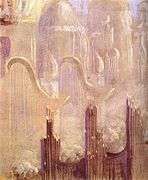 Creation of the World - XII (1906-1907)
Creation of the World - XII (1906-1907)_-_1907%2C_Druskininkai.jpg) Sonata - II (1907)
Sonata - II (1907)_-_1908.jpg) Sonata of the Sea. Finale (1908)
Sonata of the Sea. Finale (1908)_-_1908.jpg) Finale - III (1908)
Finale - III (1908)_-_1907.jpg) Fairy Tale - I (1907)
Fairy Tale - I (1907)_-_1907.jpg) Fairy Tale - III (1907)
Fairy Tale - III (1907)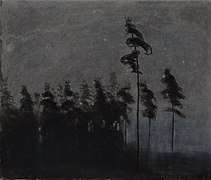 Forest (1907)
Forest (1907)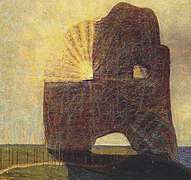 The Past (1907)
The Past (1907)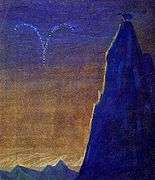 The Zodiac cycle - Aries (1907)
The Zodiac cycle - Aries (1907)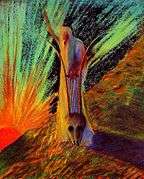 Morning Fantasy (1904)
Morning Fantasy (1904)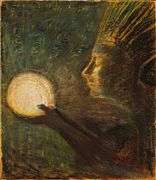 The Gift of Friendship (1906)
The Gift of Friendship (1906)_-_1909.jpg) Paradise (1909)
Paradise (1909)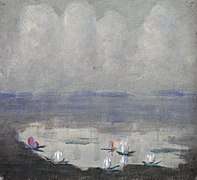 Evening (1907)
Evening (1907)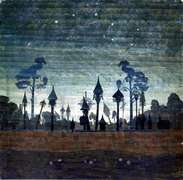 Rural Cemetery (1909)
Rural Cemetery (1909)
References
- "Mikalojus Konstantinas Čiurlionis". Lithuanian National Čiurlionis Museum.
- M.K. Ciurlionis 1875–1911: pionnier de l'art abstrait: discours prononcé au 2ème Congrès International des Critiques d'Art, Maison de l'UNESCO, Paris, 1949. A. Rannit. 1950.
- Timothy Snyder (2004). The reconstruction of nations: Poland, Ukraine, Lithuania, Belarus, 1569–1999. Yale University Press. p. 100. ISBN 978-0-300-10586-5.
- Elżbieta Dziębowska, ed. (1984). Encyklopedia muzyczna PWM: część biograficzna, Volume 2: cd. Kraków: Polskie Wydawnictwo Muzyczne. pp. 207–209. ISBN 83-224-0223-6.
- Karolina Maria Hess and Małgorzata Alicja Dulska, Kazimierz Stabrowski’s Esoteric Dimensions: Theosophy, Art, and the Vision of Femininity, La Rosa di Paracelso 1 (2017):41-65.
- Gostautas, Stasys, “M.K. Čiurlionis, The Famous Unknown”, Lituanus, vol. 49, no. 4, 2003.
- Istorija.html. M. K. Čiurlionis School Of Art
- Visual Music, 13 February through 22 May 2005, MOCA Grand Avenue Archived 10 July 2007 at the Wayback Machine
- See Kazokas, Genovaitė (2009), Musical Paintings: Life and Work of M. K. Čiurlionis (1875-1911), Vilnius: Logotipas.
- See Kazokas, Genovaitė (2009), Musical Paintings: Life and Work of M. K. Čiurlionis (1875-1911), Vilnius: Logotipas.
Further reading
- Andriušytė-Žukienė Rasute. 2002. The Art of Mikalojus Konstantinas Čiurlionis: At the Junction of Two Epochs. Vilnius: Organisation Committee Frankfurt.
- Andriušytė-Žukienė, Rasute. 2004. M.K. Čiurlionis: Tarp Simbolizmo ir Modernizmo.Vilnius: Versus Aureus.
- Čiurlionytė, Jadwyga. 1973. Atsiminimai apie M. K. Čiurlionį. Vilnius: Vaga.
- Goštautas, Stasys with Birutė Vaičjurgis-Šležas, editors. 1994. Čiurlionis: Painter and Composer. Collected Essays and Notes, 1906-1989. Vilnius: Vaga.
- Kazokas, Genovaitė. 2009. Musical Paintings: Life and Work of M. K. Čiurlionis (1875-1911). Vilnius: Logotipas.
- Rannit, Aleksis. 1984. M.K. Čiurlionis: Lithuanian Visionary Painter. Chicago: Lithuanian Library Press.
- Vorobjov, Nikolai. 1938. M.K. Čiurlionis, der litauisches Maler und Musiker. Kaunas and Leipzig: Verlag Pribačis.
External links
| Wikimedia Commons has media related to Mikalojus Konstantinas Čiurlionis. |
- Mikalojus Konstantinas Čiurlionis: Life, Paintings, Music
- Biography at the Lithuanian Music Information and Publishing Centre
- Free scores by Mikalojus Konstantinas Čiurlionis at the International Music Score Library Project (IMSLP)
- The complete Piano Music of Mikalojus Konstantinas Čiurlionis: Nikolaus Lahusen/Rokas Zubovas
- Mikalojus Konstantinas Čiurlionis at AllMusic
- Mikalojus Konstantinas Čiurlionis at Find a Grave